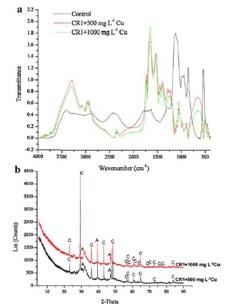Copper is an essential micronutrient critical for cell function, playing a vital role in processes including but not limited to respiration, photosynthesis and some superoxide dismutases. However, copper at high concentrations leads to plant phytotoxicity, which in turn facilitates lateral dispersion of metal particles through wind erosion. The development of mining, smelting and processing of copper ores has caused contamination of soils in China.
A variety of conventional technologies are currently available to remediate soils contaminated with toxic metals, such as physico-chemical extraction, stabilization/solidification, land filling, soil washing, and excavation. However, these methods suffer from high costs associated with energy and chemical consumption. Another method, bioremediation, which involves the use of microorganisms to remove environmental contaminants, has received increasing attention as an effective biotechnological approach to clean up a polluted environment. Microbially induced calcite precipitation (MICP) seems to provide an alternative way to solve the problem of contaminated soils.
In order to bioremediate copper from contaminated soil, an indigenous calcite precipitating bacterium Kocuria flava was isolated and its ability to remediate coppercontaminated soil was investigated by Dr. ACHALA Varenyam, prof. PAN Xiangliang and ZhANG Daoyong. FTIR (Fourier transform-infrared) and XRD (X-ray diffraction) analyses were carried for bioremediation mechanism based on MICP process. An indigenous calcifying bacterial strain CR1, identified as K. flava, was isolated from soil of a mining area, Urumqi, China. This is for the first time K. flava has been isolated and characterized for copper remediation.
By analysis they found that K. flava CR1 removed 97% of copper when initial Cu concentration was 1000 mg L−1. The isolate produced significant amount of urease (472 U mL−1), an enzyme that leads to calcite precipitation. The isolate removed 95% of copper from contaminated soil. The MICP process in bioremediation was further confirmed by FTIR and XRD analyses. FTIR analysis showed two different forms of calcium carbonate, i.e., calcite and aragonite, and the results were well supported by XRD. For the first time, the ability of K. flava has been documented in the bioremediation of polluted soil. This study showed that MICP-based bioremediation by K. flava is a viable, environmental friendly technology for cleaning-up the copper-contaminated site.
This work has been published on Ecological Engineering, 2011, 37(10): 1601–1605. It can be link from: http://www.sciencedirect.com/science/article/pii/S0925857411001868.
This work was supported by Knowledge Innovation Program of Chinese Academy of Sciences (KZCX2-YW-335), Program of 100 Distinguished Young Scientists of the Chinese Academy of Sciences, National Natural Science Foundation of China (40673070, 40872169 and 41072195) and Chinese Academy of Sciences Fellowships for Young International Scientists (2010Y2ZB04).

Fig. 4. (a) FTIR analysis, and (b) XRD spectra, conforming calcite precipitation induced by Kocuria flava CR1 grown in NBU media containing 500 and 1000 mg L−1 copper (C–calcite; A–aragonite).

